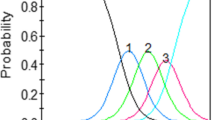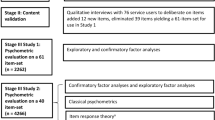Abstract
Purpose
Item response theory (IRT) scoring provides T-scores for physical and mental health subscales on the Patient-Reported Outcomes Measurement Information System Global Health questionnaire (PROMIS-GH) even when relevant items are skipped. We compared different item- and score-level imputation methods for estimating T-scores to the current scoring method.
Methods
Missing PROMIS-GH items were simulated using a dataset of complete PROMIS-GH scales collected at a single tertiary care center. Four methods were used to estimate T-scores with missing item scores: (1) IRT-based scoring of available items (IRTavail), (2) item-level imputation using predictive mean matching (PMM), (3) item-level imputation using proportional odds logistic regression (POLR), and (4) T-score-level imputation (IMPdirect). Performance was assessed using root mean squared error (RMSE) and mean absolute error (MAE) of T-scores and comparing estimated regression coefficients from the four methods to the complete data model. Different proportions of missingness and sample sizes were examined.
Results
IRTavail had lowest RMSE and MAE for mental health T-scores while PMM had lowest RMSE and MAE for physical health T-scores. For both physical and mental health T-scores, regression coefficients estimated from imputation methods were closer to those of the complete data model.
Conclusions
The available item scoring method produced more accurate PROMIS-GH mental but less accurate physical T-scores, compared to imputation methods. Using item-level imputation strategies may result in regression coefficient estimates closer to those of the complete data model when nonresponse rate is high. The choice of method may depend on the application, sample size, and amount of missingness.





Similar content being viewed by others
References
Rombach, I., Gray, A. M., Jenkinson, C., Murray, D. W., & Rivero-Arias, O. (2018). Multiple imputation for patient reported outcome measures in randomised controlled trials: Advantages and disadvantages of imputing at the item, subscale or composite score level. BMC Medical Research Methodology. https://doi.org/10.1186/s12874-018-0542-6.
Altman, D. G. (2009). Missing outcomes in randomized trials: Addressing the dilemma. Open Medicine,3(2), e51–e53.
Hutchings, A., Neuburger, J., Grosse Frie, K., Black, N., & van der Meulen, J. (2012). Factors associated with non-response in routine use of patient reported outcome measures after elective surgery in England. Health and Quality of Life Outcomes. https://doi.org/10.1186/1477-7525-10-34.
Little, R. J., & Rubin, D. B. (2002). Statistical analysis with missing data (2nd ed.)., Wiley series in probability and statistics Hoboken, NJ: Wiley.
Rubin, D. B. (1987). Multiple imputation for nonresponse surveys. New York: John Wiley & Sons.
van Buuren, S. (2012). Flexible imputation of missing data (1st ed.). New York: Chapman and Hall.
Cella, D., Yount, S., Rothrock, N., Gershon, R., Cook, K., Reeve, B., et al. (2007). The patient-reported outcomes measurement information system (PROMIS): Progress of an NIH roadmap cooperative group during its first two years. Medical Care,45(5), S3–S11. https://doi.org/10.1097/01.mlr.0000258615.42478.55.
Health Measures: Transforming how Health is Measured. Retrieved Dec 27, 2018, from http://www.healthmeasures.net/score-and-interpret/calculate-scores.
Lapin, B., Thompson, N. R., & Katzan, I. L. (2018). Letter by Lapin et al regarding article, “PROMIS GH (Patient-Reported Outcomes Measurement Information System Global Health) scale in stroke: A validation study”. Stroke,49, 180–186. https://doi.org/10.1161/STROKEAHA.117.018766.
Hays, R. D., Bjorner, J. B., Revicki, D. A., Spritzer, K. L., & Cella, D. (2009). Development of physical and mental health summary scores from the patient-reported outcomes measurement information system (PROMIS) global items. Quality of Life Research,18(7), 873–880. https://doi.org/10.1007/s11136-009-9496-9.
Collins, L. M., Schafer, J. L., & Kam, C.-M. (2001). A comparison of inclusive and restrictive strategies in modern missing data procedures. Psychological Methods,6(4), 330–351. https://doi.org/10.1037/1082-989X.6.4.330.
Thompson, N. R., Lapin, B. R., & Katzan, I. L. (2017). Mapping PROMIS Global Health items to EuroQol (EQ-5D) utility scores using linear and equipercentile equating. PharmacoEconomics,35(11), 1167–1176. https://doi.org/10.1007/s40273-017-0541-1.
Simons, C. L., Revero-Arias, O., Yu, L. M., & Simon, J. (2015). Multiple imputation to deal with missing EQ-5D-3L data: Should we impute individual domains or the actual index? Quality of Life Research,24, 805–815. https://doi.org/10.1007/s11136-014-0837-y.
Katzan, I. L., Speck, M., Dopler, C., Urchek, J., Bielawski, K., Dunphy, C., et al. (2011). The knowledge program: An innovative, comprehensive electronic data capture system and warehouse. AMIA Annual Symposium Proceedings (pp. 683–692).
van Buuren, S., Brand, J. P. L., Groothuis-Oudshoorn, C. G. M., & Rubin, D. B. (2006). Fully conditional specification in multivariate imputation. Journal of Statistical Computation and Simulation,76(12), 1049–1064. https://doi.org/10.1080/10629360600810434.
Yu, L. M., & Rivero-Arias, O. (2007). Evaluation of software for multiple imputation of semi-continuous data. Statistical Methods in Medical Research,16, 243–258. https://doi.org/10.1177/0962280206074464.
van Buuren, S., & Groothuis-Oudshoorn, C. (2011). Mice: Multivariate imputation by chained equations in R. Journal of Statistical Software,45(3), 1–67.
R Core Team. (2018). R: A language environment for statistical computing. Vienna: R Foundation for Statistical Computing.
Graham, J. W., Olchowski, A. E., & Gilreath, T. D. (2007). How many imputations are really needed? Some practical clarifications of multiple imputation theory. Prevention Science,8, 206–213. https://doi.org/10.1007/s11121-007-0070-9.
Funding
No external funding was received.
Author information
Authors and Affiliations
Contributions
NRT, BRL: conceived and designed the study. NRT: analyzed the data and wrote first draft. All authors: critically revised the manuscript. All authors: reviewed and approved the final manuscript.
Corresponding author
Ethics declarations
Conflict of interest
All authors declare that they have no conflict of interest.
Ethical approval
All procedures performed in studies involving human participants were in accordance with the ethical standards of the institutional and/or national research committee and with the 1964 Helsinki declaration and its later amendments or comparable ethical standards.
Informed consent
This study was approved by the Cleveland Clinic Institutional Review Board (IRB # 07-591). Because the study involved retrospective analysis of data acquired as part of standard of care, informed consent was waived. For this type of study formal consent is not required.
Additional information
Publisher's Note
Springer Nature remains neutral with regard to jurisdictional claims in published maps and institutional affiliations.
Electronic supplementary material
Below is the link to the electronic supplementary material.
Rights and permissions
About this article
Cite this article
Thompson, N.R., Katzan, I.L., Honomichl, R.D. et al. PROMIS Global Health item nonresponse: is it better to impute missing item responses before computing T-scores?. Qual Life Res 29, 537–546 (2020). https://doi.org/10.1007/s11136-019-02327-1
Accepted:
Published:
Issue Date:
DOI: https://doi.org/10.1007/s11136-019-02327-1




